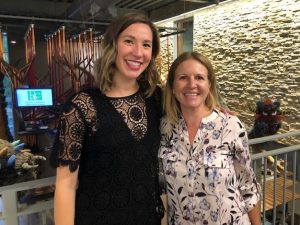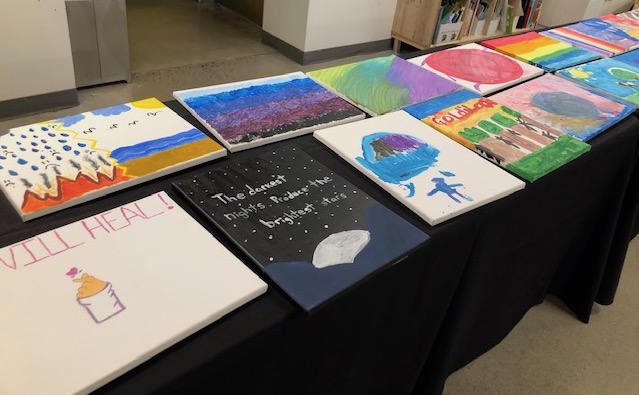Denver Children’s Advocacy Center displayed its young clients’ artwork at its September 2019 Art from the Heart event at the Children’s Museum of Denver.
All in a Day’s Work: Child Health Day
Child Health Day is observed in the United States on the first Monday of October annually. The national observance began with a joint resolution in Congress in 1928, under President Calvin Coolidge, though the observance was moved from May to October in 1960. Among organizations marking the day, the Health Resources and Services Administration has released its National Survey of Children’s Health today.

JVA Senior Grantwriter Katalin Wishart, right, and JVA Director of Client Relations Katherine Jarvis attended DCAC’s Art from the Heart event last month.
In this spirit, JVA is highlighting one of the many inspiring changemaking organizations we work with that supports children’s health and well-being—Denver Children’s Advocacy Center (DCAC). DCAC works to prevent child abuse, strengthen families and restore childhood through integrated, research-based programming.
JVA Senior Grantwriter Katalin Wishart has worked closely with DCAC to help it raise funds to support its essential services, which include: 1) community outreach and education to prevent child abuse and neglect; 2) rapid response to provide immediate support for child victims, including forensic interviews and victim advocacy; and 3) mental health treatment and integrated services to help children and families recover from traumatic experiences.
DCAC is currently raising funds so it can create a therapy garden at its child-friendly campus to expose children to the healing effects of nature as part of their treatment.
We asked Kat to share a bit about what inspires her about the organization.
1. Tell us about the projects you have worked on with DCAC. What is the organization trying to achieve?
“Although its mission can be neatly summed up with three short phrases, DCAC’s work is really complex because it works with such a vulnerable population on such a serious issue.
“DCAC was originally founded to put children’s needs at the center of child abuse investigations. Before DCAC, children at the center of child abuse investigations were often shuttled from interviews to depositions to medical examinations, having to tell their story over and over to adults they did not know, and often, critical information would get lost in the shuffle of providers.
“DCAC’s approach protects children from getting further traumatized during the investigations that are supposed to help them. Beyond forensic interviews, DCAC provides critical interventions for children who have been traumatized by abuse, neglect or violence.
“It also works to prevent child abuse by providing outreach and education in schools and childcare centers.”
“DCAC’s treatment and prevention work are so crucial because trauma at a young age—during rapid brain development—can have long-term adverse effects on children’s social-emotional and cognitive development. DCAC works with children and their families so they can have healthy, normal childhoods.”
2. What about the organization or its work inspires you?
“DCAC inspires me because they do difficult work with such a fragile and vulnerable population and create hope.

This mural was painted by a former DCAC client, with help from children receiving services from DCAC at the time.
“Everything DCAC does is centered on creating a comfortable environment for children and helping them find joy again. DCAC’s treatment facility is a campus with three sunny yellow houses. The houses are immaculate and the rooms are furnished with comfortable sofas, tables, toys and games. The treatment house is so warm and welcoming that children often talk about which rooms would be theirs if they lived there.
“Outside, there are a playground, garden boxes and attractive landscaping, all intentionally designed to put children at ease. When children are in therapy, they can create art, play with sand trays or toys, work in the garden or shoot hoops with their therapist. DCAC is now planning to build a therapy garden at its campus to provide another healing environment in which children and their families can recover from their trauma.
“DCAC knows that environment impacts outcomes, so it has deliberately created a warm, child-friendly place for children to effectively heal.”
3. Is there a particular person/people at the organization that you really admire, and why?
“DCAC’s executive director, Dr. Gizane Indart, is incredible—she is so driven and energized by her work. She really inspires hope and makes you feel like anything is possible when you talk to her.
“She is also an experienced bilingual therapist and, when needed, she personally responds to children and families in crisis. Her passion and commitment to make children’s lives better really drives DCAC’s remarkable work.”
4. What have you learned through working with this organization?
“Every time I write a grant for DCAC, I feel like I discover another layer of complexity about its work. For example, I recently learned that they started providing therapy to clients’ mothers a few years ago, which, of course, makes perfect sense.
“While some mothers are technically children themselves (and therefore fall within DCAC’s mission), some of the adult mothers also grew up experiencing abuse, neglect and violence. Because these moms have been traumatized and did not receive appropriate support as children, they do not know how to effectively support their children who are now recovering from their own trauma.
“DCAC recognizes that providing treatment to these moms is essential to improving the outcomes for their children.”
5. If I would like to support this organization, is there something in particular the organization could really use?
“DCAC has a link on its website through which anyone can donate anytime. DCAC also has an ongoing wish list, which includes art materials, toys and hygiene products. Coming up in November, DCAC will have a holiday gift drive for its clients. Gifts for 12- to 18-year-olds are always harder to come by and greatly appreciated. Gift cards are a safe bet for the teens. Other ways to help out are on the site, so if you’re interested, please reach out!”







Leave A Comment